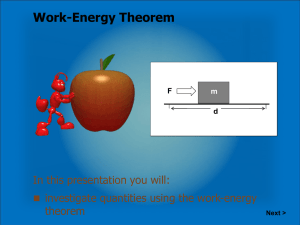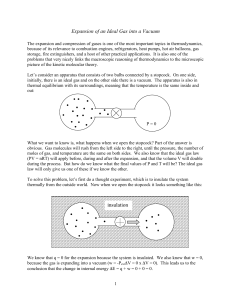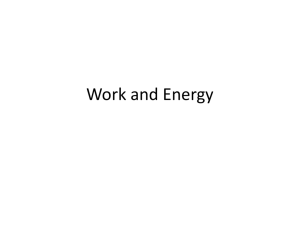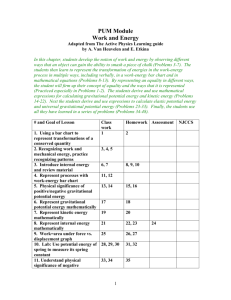File
advertisement
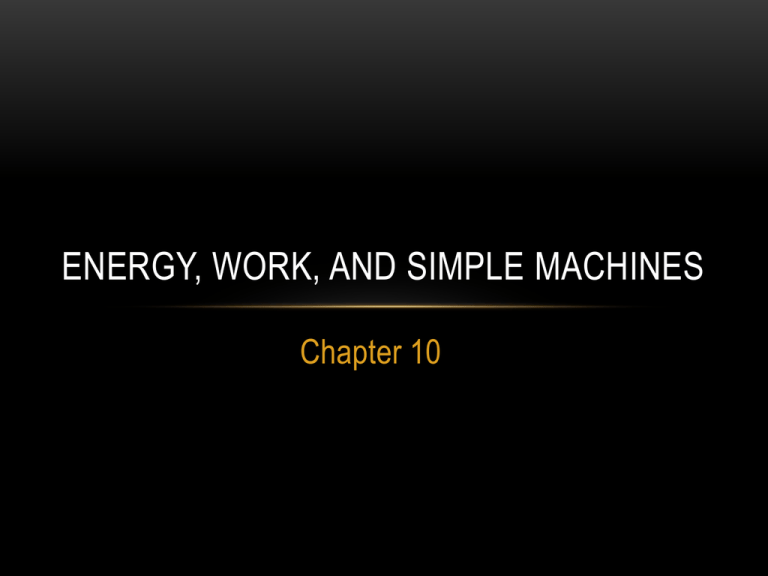
ENERGY, WORK, AND SIMPLE MACHINES Chapter 10 OBJECTIVES Chapter 10 Section 1 Chapter 10 Section 2 • Describe the relationship between work and energy. • Demonstrate a knowledge of the usefulness of simple machines. • Differentiate between ideal and real machines in terms of efficiency. • Analyze compound machines in terms of simple machines. • Calculate efficiencies for simple and compound machines. • Calculate work. • Calculate the work done by a variable force. • Calculate the power used. 10 - 1 ENERGY AND WORK WORK W = Fd Definition: • Work is the transfer of energy by mechanical means. Where: • W = work in joules (J) • Work is done when a • F = force in newtons (N) force is exerted on an object through a distance. • d = displacement in meters (m) • Work is only done if the force is applied for a distance! Note: A joule is equal to 1 Nm. KINETIC ENERGY Energy Definition: KE = ½ mv2 • The ability of an object to produce a change in itself or the world around it. Where: Kinetic Energy •KE = kinetic energy in joules (J) • The energy resulting from motion. •m = mass in kg • Represented by KE. •v = velocity in m/s WORK-ENERGY THEOREM • The work-energy theorem states that when work is done on an object, the result is a change in kinetic energy. • Determined by English physicist James Prescott Joule in the 1800’s. W = ΔKE Where: •W = work in joules (J) •ΔKE = change in kinetic energy • KEf – KEi • Measured in joules EXAMPLE - CALCULATING WORK When a club head strikes a a 46-g golf ball, the ball picks up 43 J of kinetic energy. A constant force of 2300 N is applied to the ball while the club head and ball are in contact. Over what distance is the club head in contact with the ball? Given: Equations: m = 46 g W = ΔKE ΔKE = 43 J W = Fd F = 2300 N d=? Calculations: d = ΔKE / F = 43 J / 2300 N = 0.019 m So, ΔKE = Fd d = ΔKE / F HOMEWORK p. 261 # 2+3 xkcd.com CALCULATING WORK Remember: • A force exerted in the direction of motion is given by W=Fd. • A force exerted perpendicular to the direction of motion does no work. So, how do you calculate work when a constant force is exerted at an angle? CALCULATING WORK WHEN FORCE IS EXERTED AT AN ANGLE 1.Replace the force by it’s x and y components. 2.Determine which component of the force is in the direction of the object’s displacement. 3.Use this component of the force, in W = Fd, to calculate the work done. Calculating Work – Force at an Angle Example: How much work is done in pushing a tall box 15 m with a force of 4.0 x 102 N that is applied slightly upward at an angle of 10.0° from the horizontal? F 10.0° incline Fx 15 m Given: F = 400 N d = 15 m (in x-dir) W=? *Need F in x-dir. Eqn & Calculations: W = Fd F = F in x-dir = F cos θ W = (F cos θ)d W = (400N)(cos 10)15m W = 5900 J Fy FINDING WORK WHEN FORCES CHANGE How can you calculate work when forces change? • Draw a force vs. displacement graph. • The area under the curve is equal to the work done on the object. CALCULATING WORK How do you calculate work when there is more than one force? The work-energy theorem relates the net work done on the system to its change in energy. If several forces act on an object: 1. calculate the work done by each force 2. then add them together * use components for forces that are at an angle HOMEWORK p. 262 #6-8 xkcd.com POWER • Power is the rate at which the external force changes the energy of the system. • The rate at which work is done. • Measured in watts (W) • 1 W = 1 J/s • Can also be measured in kilowatts (kW). Calculating Power work Power = time Units: Power in watts (W) Work in Joules (J) Time in seconds (s) EXAMPLE - CALCULATING POWER A net force of 2800 N accelerates a 1250-kg vehicle for 8.0 s. The vehicle travels 80.0 m during this time. What power output does this represent? Given: F = 2800 N m = 1250 kg t = 8.0 s d = 80.0 m P=? Equations: P=W/t W = Fd so: P = Fd / t Calculations: P = Fd / t P = (2800 N)(80.0 m) / 8.0 s P = 28000 W or 28 kW CLASSWORK • pg. 264 • This assignment will be checked before the end of class. • # 9-13 • QUIZ on Chapter 10 Section 1 TOMORROW! • QUIZ topics include: • Work • Energy • Work-Energy Theorem • Power 10 - 2 MACHINES WHAT ARE THE SIX SIMPLE MACHINES? 1.Lever 4.Inclined Plane 2.Wheel and Axle 5.Wedge 3.Pulley 6.Screw LEVER WHEEL AND AXLE PULLEY INCLINED PLANE WEDGE SCREW BENEFITS OF MACHINES A machine is a device that eases the load by achieving one or more of the functions at the left. • transferring a force from one place to another • changing either the magnitude of a force • changing the direction of a force • changing the distance or speed of a force MECHANICAL ADVANTAGE Effort Force (Fe) Mechanical Advantage • The force exerted by a person on a machine. • The mechanical advantage of a machine is the ratio of the resistance force to the effort force. • Also called input force. Resistance Force (F r) • The force exerted by the machine. • Also called output force. Fr MA = Fe MECHANICAL ADVANTAGE MA < 1 MA = 1 • The resulting force from the machine is less than the applied force. • The resulting force from the machine is the same as the applied force. • So, the machine changes the distance or direction of the force. • So, the machine changes the distance or direction of the force. • Ex. fishing pole • Ex. pulley MA > 1 • The resulting force from the machine is more than the applied force. • So, the machine increases the force applied by the person. • Ex. crowbar IDEAL MECHANICAL ADVANTAGE • In an ideal machine, all energy put in would be transferred out, so the input work would be equal to the output work. • Therefore, for an ideal machine, the mechanical advantage is equal to the displacement of the effort force divided by the displacement of the load – this is called ideal mechanical advantage (IMA). de IMA = dr EFFICIENCY COMPOUND MACHINES



